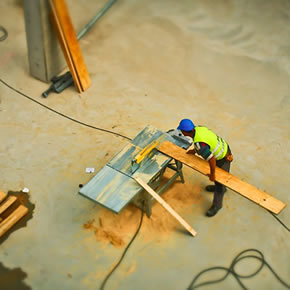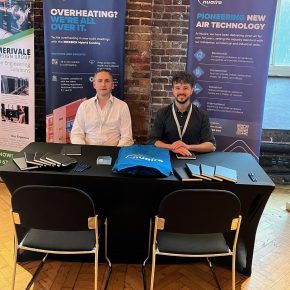
Migraine awareness in the construction industry
Chris Salmon, Operations Director at Quittance, discusses migraine-related risks in the construction industry and what can be done to raise awareness.
According to the WHO, migraine is the 6th highest cause of work absenteeism worldwide. In the UK, an estimated 8 million people (1 in 7) are affected by migraine.
Figures from the Migraine Trust show that there are over 190,000 migraine attacks every day in the UK. The condition is more common than asthma, diabetes and epilepsy combined, it is most common among adults of working age, and is prevalent in the construction industry.
Migraine in the workplace
Employers are required to provide a healthy working environment. This includes advisory measures on helping prevent migraine. Many reported migraine “trigger factors” are particularly hard to avoid on building sites – even when the employer meets all of their PPE obligations.
Migraine-related risks are particularly acute in the construction industry, where there is both a greater danger of serious injury following a health and safety breach and, according to a recent survey, a workplace culture that stigmatises illness.
Health and safety risks
In more serious cases, a migraine attack can cause brief periods of blindness or vision changes, hearing loss, and seizure. Even if a worker’s migraine is less severe, they may still experience fatigue and chronic pain.
Additionally, migraine medication side effects include drowsiness, nausea and difficulty thinking. Theories about the causes of migraines include emotional, physical, dietary, environmental and medicinal factors.
Building sites expose workers to a disproportionately high number of these triggers including:
- Noise
- Toxic substances and fumes e.g. volatile organic compounds found in most paints and solvents
- Sick building syndrome
- Light extremes
- Temperature and humidity extremes
- Carbon monoxide from working in and around plant and machinery
- Poor posture – for many trades this is unavoidable
- Neck & shoulder tension
- Low blood sugar (hypoglycaemia)
- Dehydration
A problem culture
With open communication and planning, the impact of migraine triggers can be managed, reducing health and safety risks both to an affected worker and to others.
However, migraine attracts a degree of prejudice and is often seen by non-sufferers as ‘just a headache’ – something to power on through.
Of the 20 industries included in a recent survey by There, the construction industry was ranked among the highest for respondents seeing time off work as a “weakness”.
Close to half of respondents also said that when they needed to take time off, they did not feel that they could do so, and that their manager would not understand. A similar percentage said that they felt “guilty” for taking time off for illness or injury.
When is an employer negligent?
One test for negligence considers whether an employer knew about, or reasonably should have known about, a health and safety risk. This puts the onus on the employer to do what they can to facilitate the identification of health conditions that may affect an employee’s safety.
If an employee is injured as a result of their condition, injures another worker or site visitor, or their condition worsens as a result of the employer’s failure to act, the employer may well face both court action from the injured party, and a fine issued by the HSE.
Tackling the problem
Given the prejudice that migraine sufferers sometimes face, a worker may be reluctant to come forward. It is therefore the employer’s duty to challenge the stigma and foster a culture where workers feel that they can discuss health issues with management without putting their livelihoods and the livelihoods of others at risk.
Charities such as The Migraine Trust offer advice to employers and employees to debunk myths about the condition, and help reduce the impact of trigger factors. Also more information is available in the NHS guide on managing migraines in the workplace
Latest news

17th April 2025
Nuaire shares expertise at Specifi Mechanical Services events in 2025
Indoor air quality and ventilation manufacturing specialist Nuaire is pleased to be exhibiting at the Specifi Mechanical Services events once again in 2025.
Posted in Air Conditioning, Articles, Building Industry Events, Building Industry News, Building Products & Structures, Building Services, Exhibitions and Conferences, Facility Management & Building Services, Heating, Ventilation and Air Conditioning - HVAC, Restoration & Refurbishment, Retrofit & Renovation
15th April 2025
West Fraser: CaberDek earns top marks from Home Counties carpentry specialist
A specialist carpentry sub-contractor covering housing sites across a large swathe of the Home Counties has come to value CaberDek from the West Fraser range for a variety of reasons: not least because the high quality panel product doesn’t destroy his operatives’ electric saws!
Posted in Articles, Building Industry News, Building Products & Structures, Building Systems, Case Studies, Restoration & Refurbishment, Retrofit & Renovation, Roofs, Timber Buildings and Timber Products, Wooden products
15th April 2025
GEZE: The Role of Access Control Systems in Enhancing Building Safety
Jane Elvins, Specification and Business Development Manager at GEZE UK, delves into the role of access control systems in enhancing building safety…
Posted in Access Control & Door Entry Systems, Architectural Ironmongery, Articles, Building Industry News, Building Products & Structures, Building Services, Doors, Facility Management & Building Services, Health & Safety, Restoration & Refurbishment, Retrofit & Renovation, Security and Fire Protection
11th April 2025
Don’t Do a Dave! It’s Time to Lock FIT Show 2025 in Your Calendar!
It’s that time again – FIT Show is back! You could be forgiven for thinking there won’t be much new to see when FIT Show returns to the NEC from 29 April – 1 May. Wrong!
Posted in Articles, Building Industry Events, Building Industry News, Building Products & Structures, Building Services, Continuing Professional Development (CPD's), Exhibitions and Conferences, Information Technology, Innovations & New Products, Restoration & Refurbishment, Retrofit & Renovation, Seminars, Training
 Sign up:
Sign up: